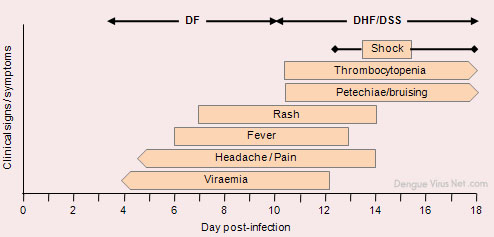Dengue hemorrhagic fever (DHF) is caused by the same viruses and is characterized by increased vascular permeability, hypovolemia, and abnormal blood clotting mechanisms. DHF is a potentially deadly complication with symptoms similar to those of dengue fever, but after several days, the patient becomes irritable, restless, and sweaty. The illness often begins with a sudden temperature rise accompanied by a facial flush and other flu-like symptoms. The fever usually continues for two to seven days and can be as high as 41°C, possibly with convulsions and other complications.
In moderate DHF cases, all signs and symptoms abate after the fever subsides. In severe cases, the patient’s condition may suddenly deteriorate after a few days of fever; the temperature drops, followed by signs of circulatory failure, and the patient may rapidly go into a critical state of shock. Dengue Shock Syndrome (DSS) is characterized by bleeding that may appear as tiny spots of blood on the skin (petechiae) and larger patches of blood under the skin (ecchymoses). Minor injuries may cause bleeding (see Figure 4). Shock may cause death within 12 to 24 hours. Patients can recover following appropriate medical treatment.
Progress towards DHF or DSS occurs after 3-5 days of fever (see Figure 3). At this time, the fever has often come down. This may mislead many of us into believing that the patient is heading toward recovery. This is the most dangerous period that requires high vigilance from caregivers.

Recognition of Dengue Haemorrhagic Fever (DHF)
- Symptoms similar to dengue fever plus any one of the following:
- Severe and continuous pain in the abdomen
- Bleeding from the nose, mouth, and gums or skin bruising
- Frequent vomiting with or without blood
- Black stools, like coal tar
- Excessive thirst (dry mouth)
- Pale, cold skin
- Restlessness, or sleepiness
Dengue shock syndrome is defined as dengue hemorrhagic fever plus:
- Weak rapid pulse
- Narrow pulse pressure (less than 20 mm Hg)
- Cold, clammy skin and restlessness.
